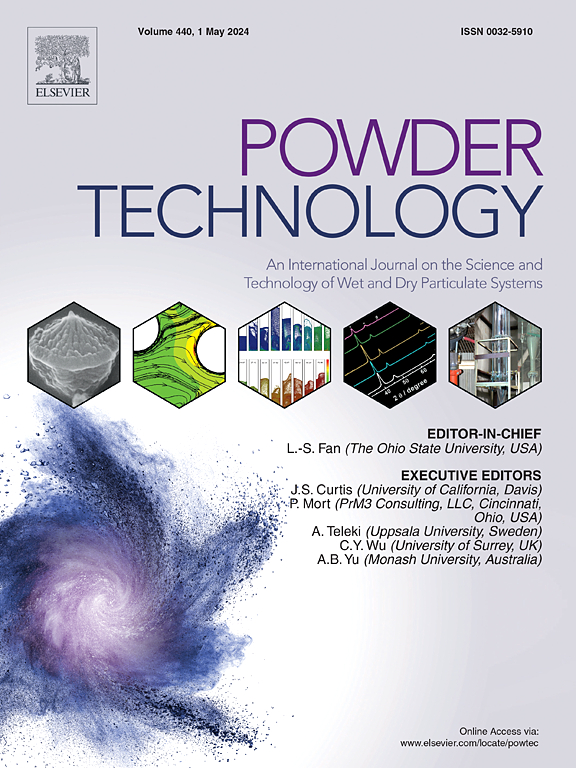液固流化床的传热特性:颗粒直径和流体的影响
IF 4.5
2区 工程技术
Q2 ENGINEERING, CHEMICAL
引用次数: 0
摘要
目前的工作涉及不同流体(牛顿流体和非牛顿流体)和颗粒大小从塔壁到流化床的传热实验研究。考虑的流体有不同浓度的水、硅酸钠(SS)和羧甲基纤维素(CMC)。研究了不同粒径下床层空隙率(ε)和表面液体流速(vs)对换热系数(h)的影响。随着表面液体流速的增加,床层空隙增大,传热系数也随之增大。粒度由3.7744 mm增加到6.09854 mm。无论是牛顿流体还是非牛顿流体,传热系数都呈增大趋势,在床层空隙≈0.7时达到最大值,然后减小。对于22% SS、2.5% CMC和3.5% CMC,流化系统处于骨料状态,而对于14% SS和水,流化系统从颗粒变为骨料。此外,建立了床壁到床体的传热机理,发现床体在径向上的温度分布不是平坦的,并且床体对总换热阻力的贡献很大。本文章由计算机程序翻译,如有差异,请以英文原文为准。

Heat transfer characteristics in a liquid-solids fluidisation bed: Effect of particle diameter and fluids
Present work deals with experimental study of heat transfer from column wall to fluidised bed for different fluids (Newtonian and non-Newtonian) and particle sizes. Fluids considered are water, sodium silicate (SS) and carboxymethyl cellulose (CMC) with different concentrations. The influence of bed-voidage (ε) and superficial liquid velocity (vs) for different particle size, on heat transfer coefficient (h) is studied. For an increase in superficial liquid velocity, bed-voidage is increased and hence the heat transfer coefficient. The particle size is increased from 3.7744 mm to 6.09854 mm. For both Newtonian and non-Newtonian fluids, it is observed the value of heat transfer coefficient increased, attained a maximum value at a bed-voidage of ≈0.7 and then decreased. For 22 % SS, 2.5 % CMC and 3.5 % CMC, the fluidisation system is in aggregate regime, whereas for 14 % S.S. and water, regime changed from particulate to aggregate. Furthermore, heat transfer mechanism from wall-to-bulk of bed has been established and it is found that temperature profiles in radial direction is not flat and there is significant contribution to overall heat transfer resistance from the bulk of the bed.
求助全文
通过发布文献求助,成功后即可免费获取论文全文。
去求助
来源期刊

Powder Technology
工程技术-工程:化工
CiteScore
9.90
自引率
15.40%
发文量
1047
审稿时长
46 days
期刊介绍:
Powder Technology is an International Journal on the Science and Technology of Wet and Dry Particulate Systems. Powder Technology publishes papers on all aspects of the formation of particles and their characterisation and on the study of systems containing particulate solids. No limitation is imposed on the size of the particles, which may range from nanometre scale, as in pigments or aerosols, to that of mined or quarried materials. The following list of topics is not intended to be comprehensive, but rather to indicate typical subjects which fall within the scope of the journal's interests:
Formation and synthesis of particles by precipitation and other methods.
Modification of particles by agglomeration, coating, comminution and attrition.
Characterisation of the size, shape, surface area, pore structure and strength of particles and agglomerates (including the origins and effects of inter particle forces).
Packing, failure, flow and permeability of assemblies of particles.
Particle-particle interactions and suspension rheology.
Handling and processing operations such as slurry flow, fluidization, pneumatic conveying.
Interactions between particles and their environment, including delivery of particulate products to the body.
Applications of particle technology in production of pharmaceuticals, chemicals, foods, pigments, structural, and functional materials and in environmental and energy related matters.
For materials-oriented contributions we are looking for articles revealing the effect of particle/powder characteristics (size, morphology and composition, in that order) on material performance or functionality and, ideally, comparison to any industrial standard.
 求助内容:
求助内容: 应助结果提醒方式:
应助结果提醒方式:


